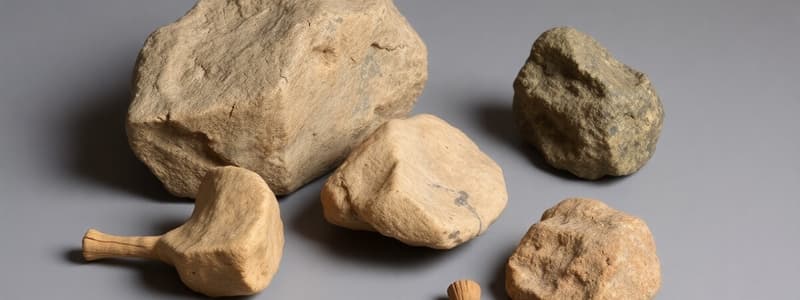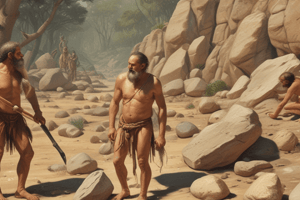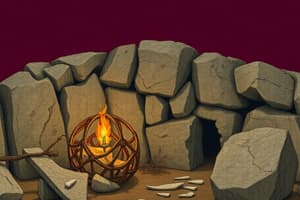Podcast
Questions and Answers
Which of the following best describes how early humans developed an understanding of science?
Which of the following best describes how early humans developed an understanding of science?
- By observing their environment, recording patterns, analyzing information, and looking for answers. (correct)
- Through complex mathematical calculations and controlled laboratory experiments.
- By relying solely on inherited knowledge and traditions passed down through generations.
- Through accidental discoveries without any systematic observation or analysis.
The discovery of mud plaster, which led to pottery and mud brick houses, primarily resulted from what?
The discovery of mud plaster, which led to pottery and mud brick houses, primarily resulted from what?
- A complex understanding of chemical reactions.
- The search for food, survival needs, practical reasons, and curiosity. (correct)
- A desire to create aesthetically pleasing art.
- The pursuit of advanced engineering techniques.
During the Stone Age, the degree of sophistication in tool fashioning and use was the basis for dividing it into which periods?
During the Stone Age, the degree of sophistication in tool fashioning and use was the basis for dividing it into which periods?
- Bronze, Iron, and Steel.
- Early, Middle, and Late.
- Paleolithic, Mesolithic, and Neolithic. (correct)
- Formative, Classical, and Post-Classical.
Flint and chert were primarily used in the Stone Age for what purpose?
Flint and chert were primarily used in the Stone Age for what purpose?
Which of the following is an example of an invention, as opposed to a discovery, from the content provided?
Which of the following is an example of an invention, as opposed to a discovery, from the content provided?
How did the prepared core technique improve stone tool production during the Middle Paleolithic period?
How did the prepared core technique improve stone tool production during the Middle Paleolithic period?
Which of the following best describes a key advancement that occurred during the Neolithic Period, distinguishing it from earlier periods?
Which of the following best describes a key advancement that occurred during the Neolithic Period, distinguishing it from earlier periods?
What distinguishes Acheulean toolkits from Oldowan toolkits in prehistoric technology?
What distinguishes Acheulean toolkits from Oldowan toolkits in prehistoric technology?
How did the invention of tools like needles and thread, harpoons, and spear throwers impact Middle Stone Age societies?
How did the invention of tools like needles and thread, harpoons, and spear throwers impact Middle Stone Age societies?
A team of archaeologists discovers a collection of stone tools characterized by hammer stones with battered surfaces. Based on these findings, to which tool industry do these tools likely belong and which hominin species is thought to be associated with their creation?
A team of archaeologists discovers a collection of stone tools characterized by hammer stones with battered surfaces. Based on these findings, to which tool industry do these tools likely belong and which hominin species is thought to be associated with their creation?
Which of the following characteristics is most indicative of the transition from the Neolithic period to the Bronze Age?
Which of the following characteristics is most indicative of the transition from the Neolithic period to the Bronze Age?
How did the invention of the wheel by the Sumerians impact their society and economy?
How did the invention of the wheel by the Sumerians impact their society and economy?
What was one primary purpose of the Sumerian clay tablets during their early use?
What was one primary purpose of the Sumerian clay tablets during their early use?
Why was the development of the sailboat significant for the Sumerians, given their geographical location?
Why was the development of the sailboat significant for the Sumerians, given their geographical location?
How did the Sumerians' advancements in astronomy influence subsequent cultures?
How did the Sumerians' advancements in astronomy influence subsequent cultures?
What distinguishes the Iron Age from the Bronze Age in terms of tool and weapon production?
What distinguishes the Iron Age from the Bronze Age in terms of tool and weapon production?
The invention of cuneiform marked a significant advancement, but what was its initial and primary application?
The invention of cuneiform marked a significant advancement, but what was its initial and primary application?
How did the discovery and management of fire during the Paleolithic Era contribute to the development of early human societies?
How did the discovery and management of fire during the Paleolithic Era contribute to the development of early human societies?
What key areas of innovation and development are attributed to the Sumerians, showcasing their broad influence on subsequent civilizations?
What key areas of innovation and development are attributed to the Sumerians, showcasing their broad influence on subsequent civilizations?
Consider the timeline of ancient technological advancements. Which of the following sequences accurately represents the order of development?
Consider the timeline of ancient technological advancements. Which of the following sequences accurately represents the order of development?
Flashcards
Oldowan toolkit
Oldowan toolkit
Basic stone tools made by early humans, including hammer stones.
Acheulean toolkit
Acheulean toolkit
Includes handaxes and 'large cutting tools'. Named after St. Acheul site in France.
Prepared core technique
Prepared core technique
A core is flaked to produce a flake of predetermined size and shape in a single blow.
Middle Stone Age Toolkits
Middle Stone Age Toolkits
Signup and view all the flashcards
Neolithic Period
Neolithic Period
Signup and view all the flashcards
Science (Early Humans)
Science (Early Humans)
Signup and view all the flashcards
Discovery
Discovery
Signup and view all the flashcards
Invention
Invention
Signup and view all the flashcards
Stone Age
Stone Age
Signup and view all the flashcards
Paleolithic Tool Traditions
Paleolithic Tool Traditions
Signup and view all the flashcards
Bronze Age
Bronze Age
Signup and view all the flashcards
Iron Age
Iron Age
Signup and view all the flashcards
Sumerian Civilization
Sumerian Civilization
Signup and view all the flashcards
Cuneiform
Cuneiform
Signup and view all the flashcards
Sumerian Clay Tablet
Sumerian Clay Tablet
Signup and view all the flashcards
Concept of Wheels
Concept of Wheels
Signup and view all the flashcards
Sailboat
Sailboat
Signup and view all the flashcards
Sumerians as Astronomers
Sumerians as Astronomers
Signup and view all the flashcards
Sumerian Foundations
Sumerian Foundations
Signup and view all the flashcards
Study Notes
- Humans are curious about the world, observing nature to find patterns and answers, which leads to understanding science.
- As science advances, ancient humans discovered and invented applicable tools and methods.
- Archeological excavations are a key source of data and evidence from this era.
- The development of science and tech was a response to the search for food, survival and general curiosity.
Evidence of Science and Technology during Pre-Historic Times (3000-5000 B.C.)
- Mankind's scientific achievements are categorized as discoveries and inventions.
Stone Age
- Started 3.4 million years ago
- Divided into the Paleolithic (Early), Mesolithic (Middle), and Neolithic (New) periods, each varying on the methods of tool usage and sophistication
Four Fundamental Traditions of Paleolithic Ancestors
- Pebble-tool traditions
- Bi-facial tool or hand-axed traditions
- Flake-tool traditions
- Blade-tool traditions
- Stone tools came from flint and chart, shaped as cutting tools, flakes, blades, and weapons
- Flaking produces tools for cutting, scraping, chopping and sawing
The Early Stone Age
- The most basic stone toolkits were most commonly made
- Oldowan toolkits consist of hammer stones that show damage.
- Oldowan tools are thought to be made by Homo habilis.
- Studies suggest these tools came from Australopithecus afarensis around 3.4 million years ago.
- Oldowan tools were so simple its hard to distinguish the difference between naturally created objects and the tools, producing 3 inches of cutting edges from a pound of flint
- Acheulean toolkits have characteristics of handaxes that are cutting tools and other kinds of “large cutting tools”.
- Acheulean stone tools were named after the site of St. Acheul on the Somme River in France where artifacts from this tradition were discovered in 1847.
- They were often bifacial and produced around 12 inches of edges from a pound of flint..
- During the middle Paleolithic time, the pace of innovation in stone technology accelerated.
- Prepared core technique was an innovation that was applied in which a core was carefully flaked on one side meaning a flake of predetermined size and shape could be produced in a single blow.
Middle Stone Age Toolkits
- Had points hafted on the shafts to make spears and also stone awls used to perforate hides an scrapers
- Inventions from the time included needles and thread, skin clothing, harpoons, spear throwers, and fishing equipment
Neolithic Period
- Was characterized primarily by herding societies, bronze smelting, and agriculture
- Saw a shift from food gathering to food production and the development of pottery with sediments and clay
Bronze Age
- Approximately dated from 3000 BC to 1200 BC
- The second principal period of the three age Stone-Bronze-Iron system, generally following the Neolithic period
- Characterized by the beginning of mining and metallurgy and was the first time bronze was used
- During this humans began smelting copper and alloying it with tin or arsenic to make bronze tools and weapons.
Iron Age
- Approximately dated from 5ooBC-332 BC
- The dominant material for making tools was iron
- Characterized by the production of tools and weaponry using ferrous metallurgy.
- Meteoritic iron use dates back to 3200 BC
- Discovery of mud plaster led to pottery, mud bricks, and houses
- The first known pottery originated in Japan around 10,000 BC
Prehistoric Times
- Fire was humans most important discovery and/or invention
Lesson 2: Evidences of Science and Technology during Ancient Times (3500 B.C.-1200 in the Old World
- Sumerian Civilization: Located at the southernmost region of ancient Mesopotamia (Iraq & Kuwait).The oldest-known civilization that was established around 3600 BC.
Science and Technology Development
- Cuneiform is a historic writing system.
- The system used word-pictures depicted in symbols(3100BC)
Sumerian Clay Tablet
- Contains Sumerian historical information and culture.
- They began as record keeping for trade and evolved into the use of symbols for writing down laws and stories
Concept of Wheels
- Invented shortly after 3500 BC (potter's wheel)
- Made out of a flat disk of hardened clay
- Sumerians put the wheels on their side and hooked on wagons to aid in moving heavy objects
Sailboat
- Invented by Ancient Mesopotamia
- Mesopotamia was between Euphrates and Tigris rivers and water transportation was needed
The Sumerians in Astronomy
- The first astronomers, mapping the movement of stars, planets and moons into sets of constellations. The ancient Greeks later recognized this
- They were recognized for building the foundation of logic, mathematics, engineering, architecture, agriculture, transportation, and medicine
Sexagesimal System
- Counting in units of 60 which served as the basis of 360 degrees and the 60-minute hour
- They developed systematized techniques for farming, including seed plows and irrigation
- Wool from sheep was made into textiles, and they mastered the arts of bleaching and dyeing
Babylonian Civilization
- Located in the ancient region bordering the Tigris and Euphrates rivers
- Babylon was the capital, serving as a commercial and religious center
Hammurabi (1792-1750) in Science and Tech
- Hammurabi was the first leader of the old Babylonian empire
- Promulgated the famous Law code that served as the rule and standard
Nebuchadnezzar II in Science and Tech
- A Neo-Babylonian emperor who ordered the construction of the famous “Hanging Gardens of Babylon” and Isthar Gate
- Contributed to the development of science and technology like irrigation system canals. The Sumerian sexagesimal system was adopted
Egyptian Civilization
- Located in Northeastern Africa along the Nile River, approximately 5,000 BCE
- Ancient Egyptians learned to heat metals and make weapons and utensils, including glass, jars and glass beads.
- Egyptians wrote ink and brushes made of papyrus reeds
- Showed knowledge of anatomy and medicinal plants
- Created a calendar composed of 29 days and ¹½ days that later on have 365 days, based on astronomy
- Egyptians engaged in cooking and lived in pottery housing.
- Created canals, dikes, and ditches with outlet systems, cooking, breeding animals, producing beauty products, building sphinxes, Giza necropolis', temple ruins and more
Cretan (Minoan) Civilization
- Arose on and around the island of Crete. Flourished from approximately 2600 to 1400 BC.
- Minoan civilization was an Aegean Bronze Age civilization ruled by King Minos.
- Knossos was a large city and cultural center.
- They were primarily mercantile people involved in overseas trade. Crete was known for its exports of wine, dile, and jewelry.
- They built the first major navy ship for trading
- Minoans were skilled carvers with knowledge of mathematics, engineering, and architecture
- They constructed drainage systems, public halls, courtyards, and religious shrines
- They practiced agriculture (Polyculture) and animal breeding
- Around 1600 BC, they was shaken by a violent earthquake. Fifty years after the civilization was wiped out after the Theran eruption
- Clay Tablets had Cuneiform characters imprinted by a reed pen
- Egyptians originally called Obelisk "tekheru". A tall, four-sided tapering monument ending in a pyramid-like shape
- Sundial is a shadow clock from 1000-1500 BC. It tells time by the shadow reflected by the sun
Studying That Suits You
Use AI to generate personalized quizzes and flashcards to suit your learning preferences.




